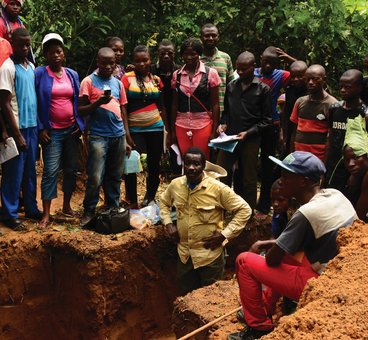PhD alumnus Esakakondo “Al” Lohese aims to address soil health and food insecurity in his home country in Central Africa.

When Esakakondo “Al” Lohese began his PhD in Land and Atmospheric Science, he had a clear mission: To restore the soil in Sankuru province, which lies in the geographic center of Lohese’s home country of the Democratic Republic of the Congo, known as DRC or Congo.
“As I was growing up, food was everywhere,” recalled Lohese. Sankuru was known as an agricultural region, and staple crops of rice, banana, pineapple, potatoes, and sugar cane grew abundantly. Lohese comes from a family of farmers, and he remembers helping his mother in the field as a child. But today, hunger is a major issue; throughout the country, 26 million people—more than a quarter of the population— are acutely food insecure, according to the World Food Programme. Conflict in the area exacerbates the problem, as millions of people are displaced and the food supply struggles to keep up. Increased demand for food in some regions has led to overusing the soil without replenishing its fertility, not allowing for the rotation of crops or to lay fallow between cultivations.
Lohese saw the connection between agriculture and soil, and followed this path through higher education and his early career. He obtained a degree in soil science at National University of Zaire in 1978. For several years afterwards, he worked for Congo’s Department of Agriculture and Rural Development. “I was in the countryside, interacting with the people in the village, farmers,” recalled Lohese. He continued his education with a Master’s degree in agricultural economics at The Ohio State University, and graduated in 1992. However, Lohese eventually left the field and raised his family in the Twin Cities.
As he got older, Lohese learned that agricultural production in Congo had diminished, especially in rural areas. “Now, there is hunger in some areas. Children are malnourished,” said Lohese. Seeing the stark changes for himself on a 2014 visit to Congo to see his mother, Lohese made the decision to continue his soil science education by pursuing a PhD at the University of Minnesota, with the intention of returning to Congo to dialogue with farmers and develop local best practices for managing the natural soil resource.
There is a saying that “all agriculture is local,” and Lohese is living that statement. “I speak the local languages, I have family connections, and I’ve worked in the region in agricultural extension,” says Lohese. He believes he can change things for the better.
Putting Sankuru on the map
Congo is the second largest country in Africa and encompasses diverse biomes from equatorial rainforests to savanna. And yet, published soil maps of the country are colored in broad generalizations. “The soils of central DRC remain poorly characterized and poorly mapped,” said Lohese; only about 15% of the country has been thoroughly analyzed. Lohese contrasts the lack of data about DRC with other nearby countries like Kenya, Tanzania, Malawi, Rwanda and Burundi, which receive international attention and development funds. This lack of data makes it difficult to understand production needs on a local scale and leaves local farmers guessing.
During his PhD, Lohese sought to map and classify the soils of the DRC—specifically Sankuru province—and to add complexity and nuance to the picture. He paid special attention to the gradient of local climate and the vegetation. Accessibility would be a major issue, as roads in DRC can be unreliable; some sites were only accessible by motorcycle. Lohese spent eight months traveling across the region, not only collecting samples but making connections with farmers.
“Al conducted his PhD research near his birthplace, so it has been both professional and deeply personal; a labor of both love and duty,” said Prof. Nic Jelinski, Lohese’s PhD advisor. Lohese’s family helped out on these field trips across the province. Lohese’s brother drove the team in his truck; another brother helped dig soil pits; his sister prepared meals for the long days in the field.
Finding hope in sandy soil

Through his thesis research, Lohese found that soils in Sankuru are in general sandy, acidic, and don’t contain much organic matter. “Sandy soil is a huge challenge to food production,” said Lohese. Soil that is too sandy can easily become too dry, and may not have nutrients plants need.
However, he did find significant differences in the soil, depending on the climate and local vegetation of the site. Soils that formed under savanna grasses and shrubs had thick, dark topsoil. The savanna soils in the wetter climate zones had the most phosphorus, a key nutrient for plant growth. Lohese’s research suggests that by focusing crop production in savanna areas in the wet climate zones, farmers may be more successful than in less hospitable areas.
Lohese also sees potential in identifying local soil amendments that can nourish the soil, to help avoid the collapse in fertility that has been experienced. “Soil is kind of taken for granted,” said Lohese, and he wants to change that mindset. By nurturing and replenishing the soil, and treating it as a natural resource, he hopes the cycle of food insecurity can be broken.
Building from the ground up
In May, Lohese returned to the DRC to join the faculty at L'Université Notre Dame de Tshumbe in Sankuru Province. His emphasis will be on research and extension, testing methods to address the problems facing farmers. He plans to build capacity at the local level: “I'm initiating something that the next generation will be able to do… That’s science at the service of humanity,” said Lohese.
Lohese is encouraged by the willingness and enthusiasm of faculty here at the University of Minnesota to collaborate and support him as he transitions from graduate student to faculty member. He hopes to establish a partnership with UMN for training students in Sankuru and sharing knowledge via seminars.
“We can make some good noise around here, and people will notice and remember,” said Lohese.
